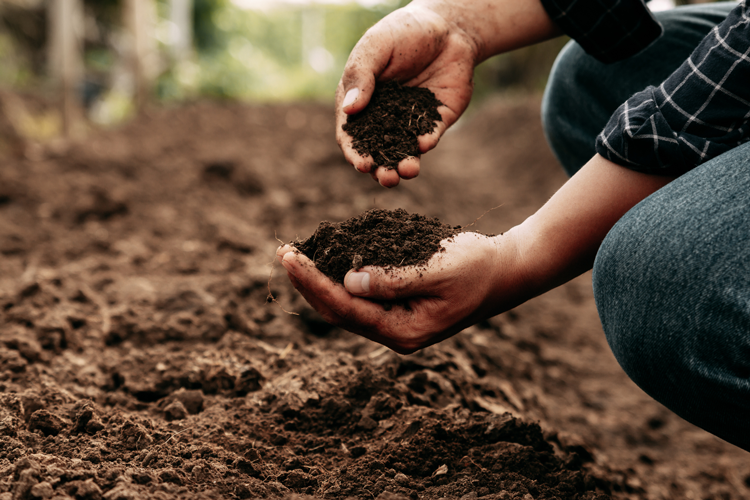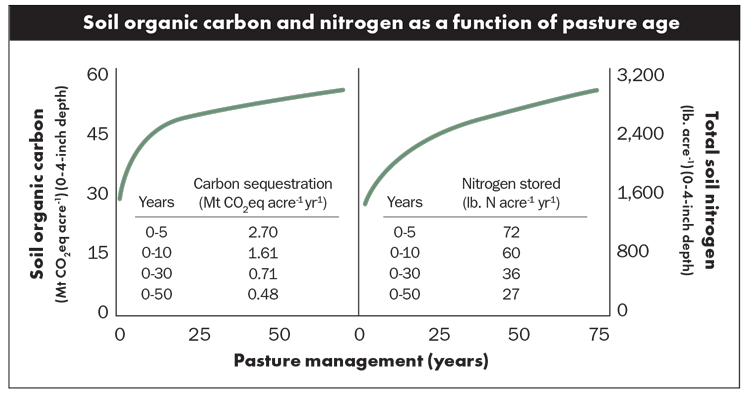The changing nature of soil |
| By Alan Franzluebbers |
|
|
The author is a soil scientist with the USDA Agricultural Research Service in Raleigh, N.C.  In the March 2024 issue of this column, it was questioned whether pastures were just right in maturity or too old and in need of renovation. Many features of a pasture need to be considered to make a renovation decision. Desirable botanical composition is a key consideration, as well as overall productivity of the pasture to meet farm needs. Farm goals, landscape features, timing, weather conditions, and economics will be important, too. However, if we focus just on accumulating as much soil carbon and nitrogen as possible, then it might be that older pastures are a desirable feature and renovation is not really necessary. The last column focused on observations from a 12-year research experiment at a single location. In this issue, I offer a perspective of soil changes while using observations from many farms across several states with a wider range of pasture ages. This survey approach can lead to large variations due to uncontrolled historical management interacting with a diversity of soil types from different physiographic regions within a multi-state assessment. However, a large number of observations can overcome some of these concerns and lead to a more general assessment. Let’s explore the details.  A large sampling domain A total of 92 tall fescue pastures were sampled to assess the nitrogen supplying capacity of soil. Fields were mostly in the Piedmont and Blue Ridge regions of North Carolina and Virginia, but a few were in Georgia, South Carolina, and West Virginia. Soil organic matter is continually exposed to competing processes of accumulation from plant material deposited on soil (dead leaves and stems, dung, and organic amendments) and in soil (roots) and loss from decomposition by soil microorganisms that feed on these organic materials. The balance between these accumulating and decomposing processes is the organic matter measured at any one point in time. Ups and downs can occur due to variable weather conditions and the seasonality of plant inputs. The 92 pastures were sorted by age based on farmer knowledge. The curves in the figure illustrate the generalized response of soil organic carbon and total soil nitrogen in the surface 4 inches as a function of pasture age. Soil organic matter is primarily composed of carbon, generally 58%. As carbon accumulates, so does nitrogen because of natural linkages in biochemical transformations. Soil organic matter generally has 10 to 15 times as much carbon as nitrogen, independent of soil type and where in the world it is found. The trend can be reversed Agricultural soils in the United States have generally been depleted of soil organic carbon and nitrogen due to the historical use of intensive tillage and low levels of plant carbon inputs to maximize economic return of commodity feed grains. After decades of soil disturbance, soils stabilize to a low level of soil organic matter. The exact level depends on climatic conditions, typical management practices deployed, and inherent soil characteristics, like textural composition. Changing the trajectory of soil organic matter decline starts when we stop disturbing it and allow soil microbial communities to feed slowly on plant residues to build soil aggregates and form soil organic matter. The quantity, quality, and timing of plant residues offered to soil bacteria, fungi, and various soil-dwelling animals can change how soil organic matter accumulates over decades when recovering from soil depletion. In this evaluation of tall fescue pastures in the eastern U.S., clear evidence was found that soil organic carbon and nitrogen accumulated as a function of pasture age (see graph). Therefore, soil under forages could be considered a sink for carbon that otherwise accumulates in the atmosphere. Nitrogen is also being stored in soil organic matter, acting as a reservoir for current and future needs to support pasture productivity. Remember, these elements are not simply sequestered but continually cycled based on plant inputs and the feeding of soil microorganisms. Humans certainly have a role to play in the ever-changing nature of the world in which we live. Have you been taking your part seriously? • Data from Franzluebbers, A.J., & Poore, M.H (2021). Tall fescue management and environmental influences on soil, surface residue, and forage properties. Agronomy Journal, 113, 2029-2043. This article appeared in the April/May 2024 issue of Hay & Forage Grower on page 15. Not a subscriber? Click to get the print magazine. |
